Influence of bacterial burden on meibomian gland dysfunction and ocular surface disease
- PMID: 31371918
- PMCID: PMC6635833
- DOI: 10.2147/OPTH.S215071
Influence of bacterial burden on meibomian gland dysfunction and ocular surface disease
Abstract
Purpose: Bacterial burden on the eyelid margin and within meibomian glands was evaluated for influence on specific ocular surface disease (OSD) markers across the meibomian gland dysfunction (MGD) spectrum.
Methods: In this prospective, observational, single-center study, 40 patients were divided into 4 equal groups of 10 that encompassed increasingly worse MGD/OSD categories. All patients answered the standard Ocular Surface Disease Index questionnaire, and underwent tear osmolarity testing (TOT), Schirmer 1, matrix metalloproteinase 9 (MMP-9) testing, meibography, and lissamine green staining. Cultures of eyelid margins and meibomian gland secretions were directly plated on blood, chocolate, and Sabouraud agar; smears were sent for gram and Papinicolau evaluation.
Results: Mean patient age was 55.25±17.22 years; there were 10 males and 30 females. TOT and MMP-9 testing were similar across groups. Culture positivity was 62.5% for right eyes, 70% for left eyes, and was not statistically different across groups (for both eyelid margin and meibomian glands). The majority of cultures were positive for coagulase-negative staphylococcus (CNS).
Conclusion: This study is in concordance with others, citing the predominance of CNS within the biofilm of both "normal" and clinically significant MGD/OSD patients. Our study exemplifies that symptoms of OSD do not necessarily correlate with degree of clinical exam findings, nor culture positivity. These results argue that bacterial burden should be reconsidered as a direct risk factor and treatment target for MGD/OSD patients.
Keywords: biofilm; blepharitis; dry eye; meibomian gland dysfunction; ocular surface disease.
Conflict of interest statement
Dr Alanna Nattis reports grants from Alcon and Glaukos Corp, outside the submitted work. Dr Eric Donnenfeld reports personal fees from Johnson & Johnson, Blephex, and Sight Sciences, during the conduct of the study and personal fees from Allergan, Alcon, Bausch & Lomband Novartis, outside the submitted work. The authors report no other conflicts of interest in this work.
Figures
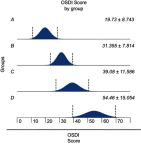
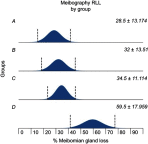
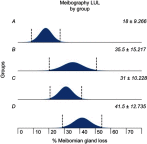

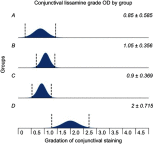
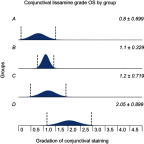
Similar articles
-
The Role of Meibography in the Diagnosis of Meibomian Gland Dysfunction in Ocular Surface Diseases.Transl Vis Sci Technol. 2019 Nov 12;8(6):6. doi: 10.1167/tvst.8.6.6. eCollection 2019 Nov. Transl Vis Sci Technol. 2019. PMID: 31737430 Free PMC article.
-
Meibomian gland dysfunction (MGD), as diagnosed by non-contact infrared Meibography, in dogs with ocular surface disorders (OSD): a retrospective study.BMC Vet Res. 2019 Dec 5;15(1):443. doi: 10.1186/s12917-019-2203-3. BMC Vet Res. 2019. PMID: 31805929 Free PMC article.
-
Functional and Morphological Evaluation of Meibomian Glands in the Assessment of Meibomian Gland Dysfunction Subtype and Severity.Am J Ophthalmol. 2020 Jan;209:160-167. doi: 10.1016/j.ajo.2019.09.005. Epub 2019 Sep 14. Am J Ophthalmol. 2020. PMID: 31526799
-
Prospective evaluation of a new intense pulsed light, thermaeye plus, in the treatment of dry eye disease due to meibomian gland dysfunction.J Optom. 2021 Apr-Jun;14(2):103-113. doi: 10.1016/j.optom.2020.08.009. Epub 2020 Oct 26. J Optom. 2021. PMID: 33121905 Free PMC article. Review.
-
In vivo Meibomian gland imaging techniques: A review of the literature.J Fr Ophtalmol. 2020 Apr;43(4):e123-e131. doi: 10.1016/j.jfo.2019.11.003. Epub 2020 Jan 9. J Fr Ophtalmol. 2020. PMID: 31928786 Review.
Cited by
-
Effects of lid debris debridement combined with meibomian gland expression on the ocular surface MMP-9 levels and clinical outcomes in moderate and severe meibomian gland dysfunction.BMC Ophthalmol. 2021 Apr 12;21(1):175. doi: 10.1186/s12886-021-01926-2. BMC Ophthalmol. 2021. PMID: 33845799 Free PMC article.
-
Safety and Tolerability of an Eye Drop Based on 0.6% Povidone-Iodine Nanoemulsion in Dry Eye Patients.J Ocul Pharmacol Ther. 2021 Mar;37(2):90-96. doi: 10.1089/jop.2020.0085. Epub 2020 Dec 23. J Ocul Pharmacol Ther. 2021. PMID: 33370213 Free PMC article.
-
Ductal Hyperkeratinization and Acinar Renewal Abnormality: New Concepts on Pathogenesis of Meibomian Gland Dysfunction.Curr Issues Mol Biol. 2023 Feb 27;45(3):1889-1901. doi: 10.3390/cimb45030122. Curr Issues Mol Biol. 2023. PMID: 36975492 Free PMC article.
-
The Role of Topical Antibiotic Prophylaxis in Oculofacial Plastic Surgery: A Randomized Controlled Study.Ophthalmology. 2020 Dec;127(12):1747-1754. doi: 10.1016/j.ophtha.2020.07.032. Epub 2020 Jul 19. Ophthalmology. 2020. PMID: 32698033 Free PMC article. Clinical Trial.
-
Potential impact of ocular intense pulsed light on eyelash microbiome in severe meibomian gland dysfunction: report of 2 cases.Front Ophthalmol (Lausanne). 2023 Nov 23;3:1240627. doi: 10.3389/fopht.2023.1240627. eCollection 2023. Front Ophthalmol (Lausanne). 2023. PMID: 38983048 Free PMC article.
References
-
- Pitts J, Lievens C. Put the squeeze on meibomian gland disease. Review of Optometry. 2009. Available from: www.reviewofoptometry.com/article/put-the-squeeze-on-meibomian-gland-dis.... Accessed July 5, 2019.
-
- Ianaro A, Ialenti A, Maffia P, et al. Anti-inflammatory activity of macrolide antibiotics. J Pharmacol ExpTher. 2000;291(1):156–163. - PubMed
LinkOut - more resources
Full Text Sources
Miscellaneous

